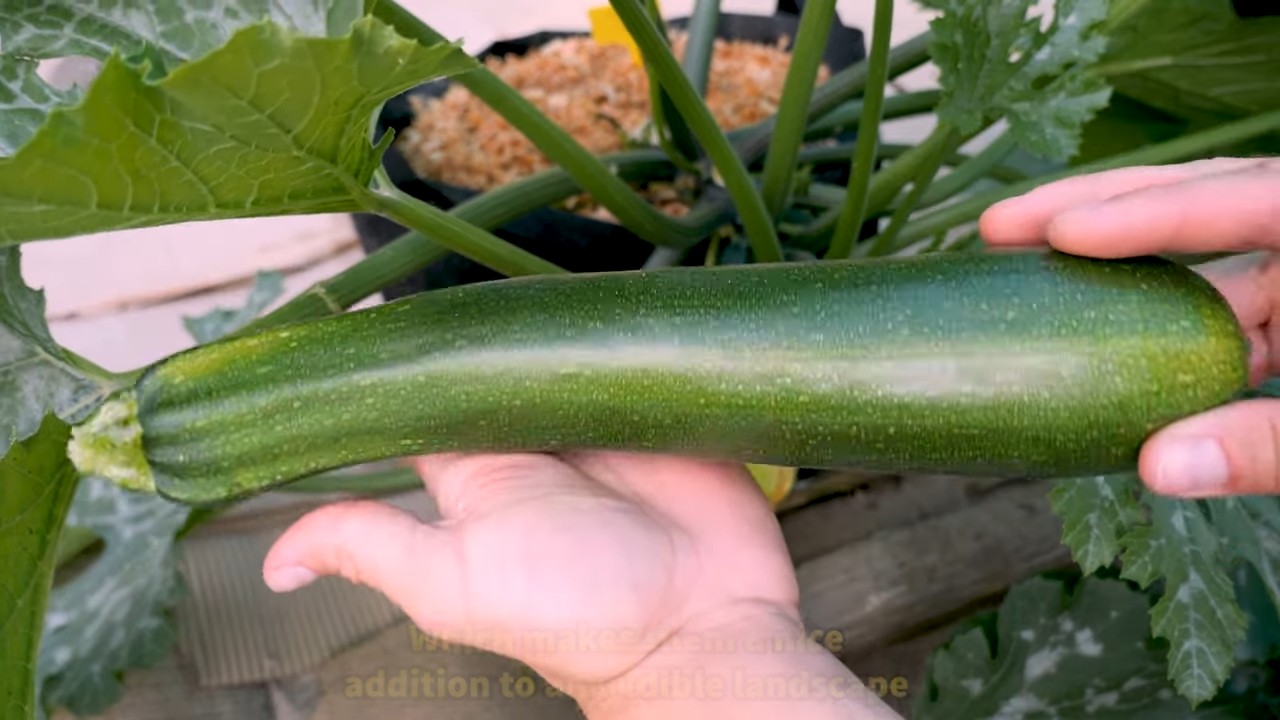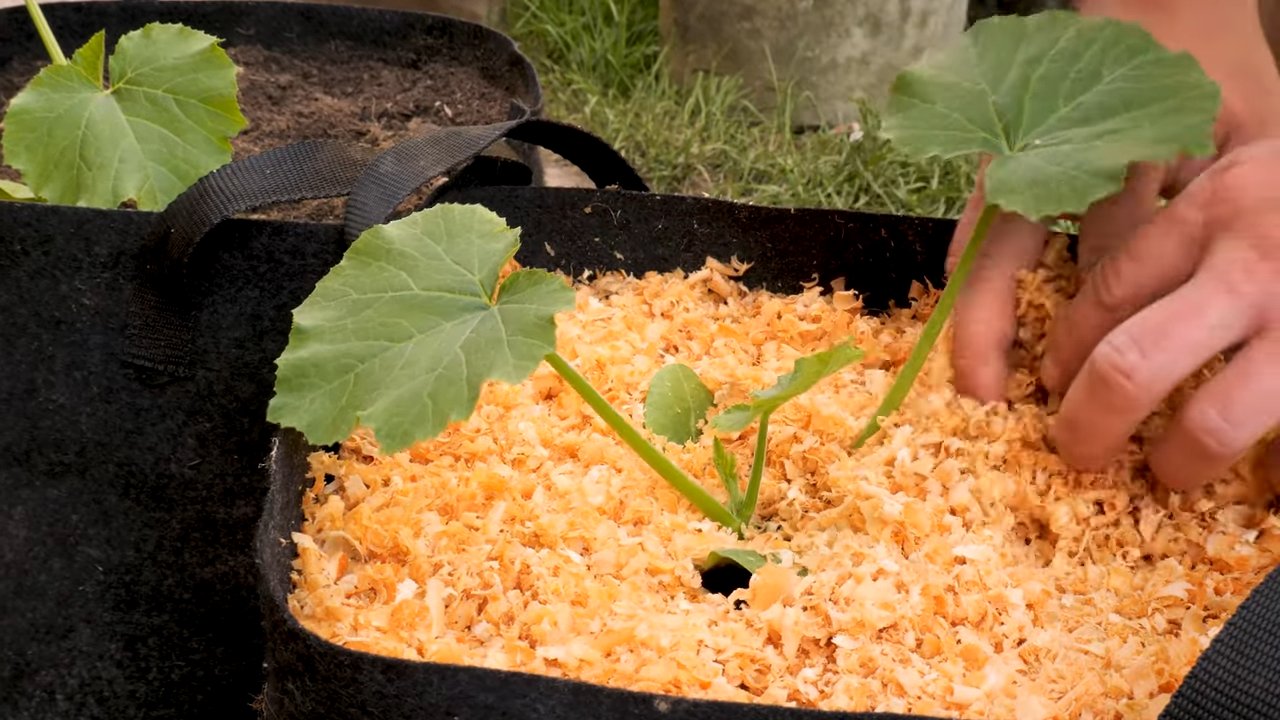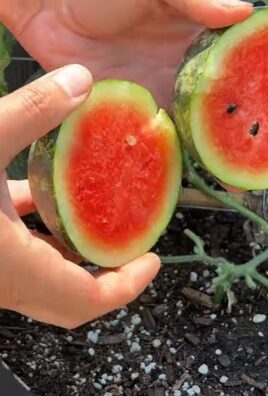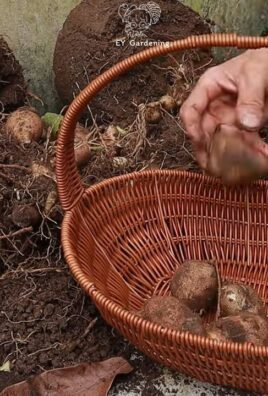Grow Zucchini in Bags? Absolutely! And I’m here to tell you it’s easier than you think! Forget sprawling garden beds and wrestling with weeds; we’re taking zucchini cultivation to a whole new level of convenience. Have you ever dreamed of harvesting baskets overflowing with fresh, vibrant zucchini, even if you only have a small balcony or patio? Well, dream no more! This DIY guide is your ticket to zucchini success, no matter your space constraints.
Zucchini, a member of the squash family, has a fascinating history, tracing back to Central and South America. While its wild ancestors were likely quite different from the tender, green delights we enjoy today, zucchini has become a staple in cuisines worldwide. From savory gratins to sweet zucchini bread, its versatility is undeniable. But traditionally, growing zucchini meant dedicating a significant chunk of garden real estate.
That’s where our ingenious bag-growing hack comes in! Why struggle with limited garden space or poor soil when you can create the perfect growing environment in a bag? This method is not only space-saving but also allows for better control over soil quality, watering, and even pest management. Plus, it’s a fantastic way to recycle those large garden bags you might already have lying around. So, if you’re ready to unlock the secrets to abundant zucchini harvests, let’s dive into this simple yet effective DIY project and learn how to grow zucchini in bags like a pro!

Grow Zucchini in Bags: A Beginner’s Guide to Bountiful Harvests
Hey there, fellow gardening enthusiasts! Are you dreaming of fresh, homegrown zucchini but short on garden space? Or maybe your garden soil isn’t quite up to par? Well, I’ve got fantastic news! You can absolutely grow zucchini in bags, and I’m here to walk you through the entire process. It’s easier than you might think, and the results are incredibly rewarding. Get ready for a zucchini bonanza!
Why Grow Zucchini in Bags?
Before we dive into the how-to, let’s talk about why growing zucchini in bags is such a great idea:
* Space Saver: Perfect for balconies, patios, or small yards. You don’t need a sprawling garden to enjoy fresh zucchini.
* Soil Control: You have complete control over the soil quality, ensuring your zucchini gets the nutrients it needs. This is especially helpful if your native soil is poor or compacted.
* Portability: Need to move your plants to chase the sun or protect them from frost? No problem! Bags make it easy.
* Reduced Weeding: Bags help minimize weed growth, saving you time and effort.
* Better Drainage: Bags typically offer better drainage than in-ground planting, preventing root rot.
* Earlier Harvest: The soil in bags tends to warm up faster in the spring, giving you a head start on the growing season.
What You’ll Need
Here’s a list of everything you’ll need to get started:
* Large Grow Bags: I recommend using bags that are at least 20 gallons in size. Fabric grow bags are ideal because they allow for good drainage and aeration. You can also use large plastic pots, but make sure they have drainage holes.
* High-Quality Potting Mix: Don’t skimp on this! Use a well-draining potting mix that’s rich in organic matter. Avoid using garden soil, as it can compact in containers. I like to use a mix of compost, peat moss (or coco coir), and perlite.
* Zucchini Seeds or Seedlings: Choose your favorite zucchini variety! Black Beauty, Costata Romanesco, and Golden Zucchini are all popular choices. You can start from seed or purchase seedlings from a local nursery.
* Slow-Release Fertilizer: This will provide your zucchini plants with a steady supply of nutrients throughout the growing season.
* Watering Can or Hose: Essential for keeping your plants hydrated.
* Trowel or Shovel: For filling the bags with potting mix and planting the seedlings.
* Optional:
* Tomato Cage or Stakes: Zucchini plants can get quite large, so you may want to provide some support.
* Mulch: To help retain moisture and suppress weeds.
* Gardening Gloves: To keep your hands clean.
Step-by-Step Instructions: Planting Your Zucchini
Alright, let’s get our hands dirty! Here’s how to plant your zucchini in bags:
1. Prepare the Grow Bags:
* First, unfold your grow bags and place them in a sunny location. Zucchini needs at least 6-8 hours of sunlight per day.
* If you’re using plastic pots, make sure they have adequate drainage holes. You can add a layer of gravel or pebbles at the bottom of the pot to improve drainage.
2. Fill the Bags with Potting Mix:
* Now, fill the grow bags with your high-quality potting mix, leaving about 2-3 inches of space at the top.
* Gently pat down the soil to remove any air pockets.
3. Add Slow-Release Fertilizer:
* Sprinkle a generous amount of slow-release fertilizer over the surface of the potting mix. Follow the instructions on the fertilizer package for the correct amount.
* Lightly mix the fertilizer into the top inch of the soil.
4. Plant the Seeds or Seedlings:
* From Seed: If you’re starting from seed, sow 2-3 seeds per bag, about 1 inch deep. Space the seeds a few inches apart. Once the seedlings emerge, thin them to one strong plant per bag.
* From Seedlings: If you’re using seedlings, gently remove them from their containers. Loosen the roots slightly before planting. Dig a hole in the potting mix that’s large enough to accommodate the root ball. Place the seedling in the hole and backfill with soil. Make sure the top of the root ball is level with the surrounding soil.
5. Water Thoroughly:
* After planting, water the bags thoroughly until the water drains out of the bottom. This will help settle the soil and ensure the roots are well-hydrated.
6. Add Mulch (Optional):
* If you want to add mulch, spread a layer of straw, wood chips, or shredded bark around the base of the plant. This will help retain moisture, suppress weeds, and regulate soil temperature.
7. Provide Support (Optional):
* If you’re using a tomato cage or stakes, insert them into the bag now, before the plant gets too big. This will help support the plant as it grows and prevent the fruits from touching the ground.
Caring for Your Zucchini Plants
Now that your zucchini plants are in their new homes, it’s time to provide them with the care they need to thrive.
1. Watering:
* Zucchini plants need consistent moisture, especially during hot weather. Water deeply whenever the top inch of soil feels dry to the touch.
* Avoid overhead watering, as this can lead to fungal diseases. Instead, water at the base of the plant.
* In general, you’ll need to water more frequently when growing in bags than you would in the ground, as the soil in bags tends to dry out faster.
2. Fertilizing:
* Even with slow-release fertilizer, your zucchini plants will benefit from supplemental feeding throughout the growing season.
* Use a balanced liquid fertilizer (such as 10-10-10) every 2-3 weeks. Follow the instructions on the fertilizer package for the correct dosage.
* You can also use organic fertilizers, such as compost tea or fish emulsion.
3. Sunlight:
* Make sure your zucchini plants are getting at least 6-8 hours of sunlight per day. If they’re not getting enough sun, they may produce fewer fruits.
4. Pest and Disease Control:
* Keep an eye out for common zucchini pests, such as squash bugs, squash vine borers, and aphids.
* Inspect your plants regularly and take action promptly if you notice any signs of infestation. You can use insecticidal soap, neem oil, or other organic pest control methods.
* Zucchini plants are also susceptible to fungal diseases, such as powdery mildew. To prevent these diseases, avoid overhead watering, provide good air circulation, and apply a fungicide if necessary.
5. Pollination:
* Zucchini plants have separate male and female flowers. The female flowers have a small zucchini fruit at the base, while the male flowers do not.
* Bees and other pollinators are essential for transferring pollen from the male flowers to the female flowers.
* If you’re not seeing many bees in your garden, you may need to hand-pollinate your zucchini flowers. To do this, use a small paintbrush to transfer pollen from the male flowers to the female flowers.
* The best time to hand-pollinate is in the morning, when the flowers are fully open.
6. Pruning:
* You can prune your zucchini plants to improve air circulation and encourage fruit production.
* Remove any yellowing or damaged leaves.
* You can also remove some of the larger leaves to allow more sunlight to reach the fruits.
7. Harvesting:
* Zucchini fruits are typically ready to harvest about 50-60 days after planting.
* Harvest them when they’re about 6-8 inches long.
* Use a sharp knife or pruners to cut the fruits from the plant.
* Harvest regularly to encourage the plant to produce more fruits. Overripe zucchini can become tough and seedy.
Troubleshooting
Even with the best care, you might encounter some challenges when growing zucchini in bags. Here are a few common problems and how to address them:
* Yellowing Leaves: This could be a sign of nutrient deficiency, overwatering, or underwatering. Check the soil moisture and adjust your watering accordingly. Fertilize with a balanced fertilizer.
* Powdery Mildew: This fungal disease appears as a white, powdery coating on the leaves. Improve air circulation, avoid overhead watering, and apply a

Conclusion
So, there you have it! Growing zucchini in bags is not just a viable alternative to traditional gardening; it’s a game-changer for those with limited space, challenging soil conditions, or simply a desire for a more controlled and convenient gardening experience. We’ve walked you through the simple steps, highlighting the benefits and offering practical tips to ensure your success.
Why is this DIY trick a must-try? Because it democratizes gardening. It empowers anyone, regardless of their living situation or gardening expertise, to cultivate fresh, delicious zucchini right at their doorstep. Imagine stepping outside your apartment balcony or small patio and harvesting plump, vibrant zucchini for your favorite summer recipes. No more relying solely on grocery store produce; you’ll have a readily available supply of homegrown goodness.
Beyond the convenience and accessibility, growing zucchini in bags offers several other advantages. The contained environment allows for better control over soil quality, moisture levels, and pest management. You can tailor the soil mix to perfectly suit zucchini’s needs, ensuring optimal growth and yields. Plus, the portability of bags means you can easily move your plants to chase the sun or protect them from harsh weather conditions.
But the beauty of this DIY project lies in its adaptability. Feel free to experiment with different bag sizes, soil amendments, and zucchini varieties. Consider adding companion plants like marigolds or basil to deter pests and attract pollinators. You can even try vertical gardening by stacking or hanging your bags to maximize space.
Here are a few suggestions and variations to get you started:
* Try different zucchini varieties: Explore heirloom varieties like ‘Costata Romanesco’ for unique flavors and textures.
* Experiment with soil mixes: Adjust the ratio of compost, perlite, and peat moss to find the perfect blend for your climate and growing conditions.
* Add a trellis: Provide support for your zucchini plants as they grow, especially if you’re growing bush varieties.
* Consider self-watering bags: These bags have a built-in reservoir that helps maintain consistent moisture levels, reducing the need for frequent watering.
* Succession planting: Plant new zucchini seeds every few weeks to ensure a continuous harvest throughout the growing season.
Ultimately, the key to success with growing zucchini in bags is observation and adaptation. Pay close attention to your plants’ needs, adjust your watering and fertilizing schedule accordingly, and don’t be afraid to experiment.
We are confident that you’ll find this DIY trick rewarding and enjoyable. The satisfaction of harvesting your own homegrown zucchini is unparalleled. So, gather your supplies, follow our guide, and get ready to embark on a zucchini-growing adventure.
We encourage you to try this method of growing zucchini and share your experiences with us! Post photos of your zucchini plants, share your tips and tricks, and let us know what worked best for you. Together, we can create a community of bag-gardening enthusiasts and inspire others to embrace the joys of homegrown produce. Happy gardening!
Frequently Asked Questions (FAQ)
What size bag is best for growing zucchini?
The ideal bag size for growing zucchini is typically between 10 and 20 gallons. A larger bag provides ample space for the roots to develop and allows the plant to access sufficient nutrients and moisture. While smaller bags can be used, they may require more frequent watering and fertilization, and the plant’s growth may be stunted. Consider the mature size of the zucchini variety you’re growing when choosing a bag size. Bush varieties may do well in 10-15 gallon bags, while larger vining varieties may benefit from 20-gallon bags or larger.
What type of soil should I use in the bags?
Zucchini plants thrive in well-draining, nutrient-rich soil. A good soil mix for growing zucchini in bags typically consists of equal parts of the following:
* Compost: Provides essential nutrients and improves soil structure.
* Potting mix: Offers good drainage and aeration.
* Perlite or vermiculite: Enhances drainage and prevents soil compaction.
You can also add slow-release fertilizer to the soil mix to provide a steady supply of nutrients throughout the growing season. Avoid using garden soil in bags, as it can become compacted and poorly drained, hindering root growth.
How often should I water my zucchini plants in bags?
The frequency of watering depends on several factors, including the weather, the size of the bag, and the type of soil mix. Generally, zucchini plants in bags need to be watered deeply whenever the top inch of soil feels dry to the touch. During hot, dry weather, you may need to water daily or even twice a day. Avoid overwatering, as this can lead to root rot. Ensure that the bags have adequate drainage holes to prevent water from accumulating at the bottom. A good way to check if your zucchini needs water is to stick your finger about an inch into the soil. If it feels dry, it’s time to water.
How much sunlight do zucchini plants need?
Zucchini plants require at least 6-8 hours of direct sunlight per day to thrive. Choose a location for your bags that receives plenty of sunlight throughout the day. If you live in a particularly hot climate, you may need to provide some afternoon shade to prevent the plants from overheating. If you’re growing zucchini indoors, use grow lights to supplement natural sunlight. Insufficient sunlight can lead to weak growth, reduced yields, and increased susceptibility to pests and diseases.
How do I fertilize zucchini plants in bags?
Zucchini plants are heavy feeders and require regular fertilization to produce abundant harvests. Start fertilizing your plants a few weeks after transplanting them into the bags. Use a balanced fertilizer with an NPK ratio of 10-10-10 or 14-14-14. You can also use organic fertilizers such as compost tea or fish emulsion. Fertilize every 2-3 weeks throughout the growing season, following the instructions on the fertilizer label. Avoid over-fertilizing, as this can burn the roots and damage the plants.
What are some common pests and diseases that affect zucchini plants?
Zucchini plants are susceptible to several pests and diseases, including:
* Squash bugs: These pests suck sap from the leaves and stems, causing wilting and stunted growth.
* Squash vine borers: These pests bore into the stems of zucchini plants, causing them to collapse and die.
* Powdery mildew: This fungal disease causes a white, powdery coating on the leaves.
* Aphids: These small insects suck sap from the leaves and stems, causing yellowing and distortion.
To prevent pests and diseases, practice good garden hygiene, such as removing dead leaves and debris. You can also use organic pest control methods such as insecticidal soap or neem oil. For powdery mildew, improve air circulation around the plants and apply a fungicide if necessary.
Can I grow zucchini in bags indoors?
Yes, you can grow zucchini in bags indoors, but you’ll need to provide adequate light and ventilation. Use grow lights to supplement natural sunlight, and ensure that the plants receive at least 6-8 hours of light per day. Provide good air circulation to prevent fungal diseases. You may also need to hand-pollinate the flowers to ensure fruit production. Indoor zucchini plants may not produce as much fruit as outdoor plants, but you can still enjoy a decent harvest.
How do I harvest zucchini?
Zucchini is typically harvested when it is young and tender, usually when it is about 6-8 inches long. Use a sharp knife or pruning shears to cut the zucchini from the plant, leaving a short stem attached. Regular harvesting encourages the plant to produce more fruit. Overripe zucchini can become tough and seedy, so it’s best to harvest them when they are still young and tender.
Can I save seeds from my zucchini plants?
Yes, you can save seeds from your zucchini plants, but keep in mind that zucchini is an open-pollinated plant, meaning that the seeds may not produce plants that are true to type. If you want to save seeds, choose a zucchini that is fully mature and allow it to ripen on the plant until the skin is hard and the flesh is dry. Remove the seeds from the zucchini, rinse them, and allow them to dry completely before storing them in an airtight container in a cool, dry place.
What are some companion plants for zucchini?
Companion planting can help improve the health and yield of your zucchini plants. Some good companion plants for zucchini include:
* Marigolds: Repel pests such as nematodes and squash bugs.
* Nasturtiums: Attract beneficial insects such as pollinators and predators.
* Basil: Repels pests and improves the flavor of zucchini.
* Beans: Fix nitrogen in the soil, benefiting zucchini plants.
* Radishes: Deter squash vine borers.
Avoid planting zucchini near potatoes, as they can compete for nutrients.




Leave a Comment